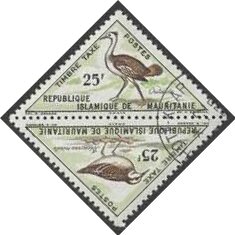Tete-Beche: Arabian Bustard and Little Stint (Mauritania 1963)
Arabian Bustard and Little Stint (Mauritania 1963)
07 September (Mauritania ) within release Birds (Postage Due) goes into circulation Tete-Beche Arabian Bustard and Little Stint face value 2*25 West African CFA franc
| Tete-Beche Arabian Bustard and Little Stint in catalogues | |
|---|---|
| Michel: | Mi: MR P40-P41 |
| Yvert et Tellier: | Yt: MR T48-T49 |
| Stanley Gibbons: | Sg: MR D191a |
Tete-Beche is square format.
Also in the issue Birds (Postage Due):
- Tete-Beche - Arabian Bustard and Little Stint face value 2*25;
- Tete-Beche - Black Stork and Vulturine Guineafowl face value 2*10;
- Tete-Beche - Grey Heron and White Stork face value 2*15;
- Tete-Beche - Red-legged Partridge and Paradise Wydah face value 2*20;
Tete-Beche Arabian Bustard and Little Stint it reflects the thematic directions:
Animals are multicellular, eukaryotic organisms of the kingdom Animalia (also called Metazoa). All animals are motile, meaning they can move spontaneously and independently, at some point in their lives. Their body plan eventually becomes fixed as they develop, although some undergo a process of metamorphosis later on in their lives. All animals are heterotrophs: they must ingest other organisms or their products for sustenance.
Birds (Aves), a subgroup of Reptiles, are the last living examples of Dinosaurs. They are a group of endothermic vertebrates, characterised by feathers, toothless beaked jaws, the laying of hard-shelled eggs, a high metabolic rate, a four-chambered heart, and a strong yet lightweight skeleton. Birds live worldwide and range in size from the 5 cm (2 in) bee hummingbird to the 2.75 m (9 ft) ostrich. They rank as the class of tetrapods with the most living species, at approximately ten thousand, with more than half of these being passerines, sometimes known as perching birds. Birds are the closest living relatives of crocodilians.
The Kionga Triangle (German: Kionga-Dreieck, Portuguese: Triângulo de Quionga) was a small region of German East Africa situated at the mouth of the Ruvuma River. The Ruvuma served as the border between the German colony and Portuguese Mozambique, and the Kionga Triangle was the only section of German East Africa south of the river. Its principal settlement was Kionga (now Quionga ) which had a population of 4,000 in 1910. It became a German possession in 1894 but came under Portuguese control in April 1916 during World War I. The post-war Treaty of Versailles reaffirmed that the river was the border between Tanganyika, then under British control, and Portuguese Mozambique. The triangle was the only territory that the treaty awarded to Portugal.


